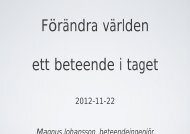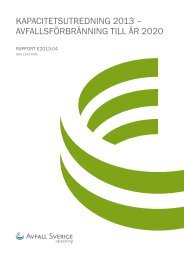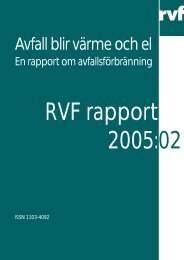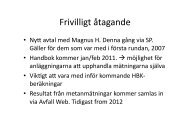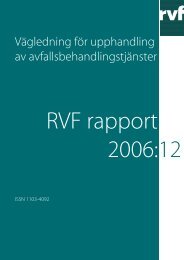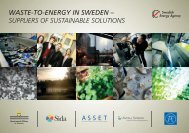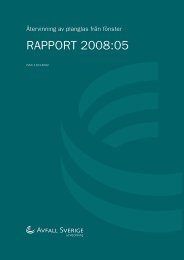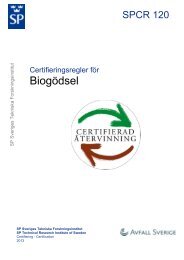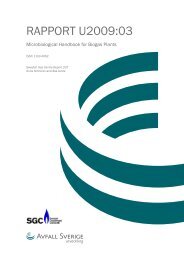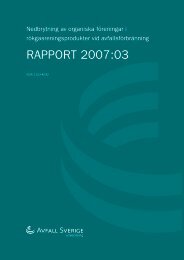2007:04 Hantering av förpackat livsmedelsavfall - Avfall Sverige
2007:04 Hantering av förpackat livsmedelsavfall - Avfall Sverige
2007:04 Hantering av förpackat livsmedelsavfall - Avfall Sverige
You also want an ePaper? Increase the reach of your titles
YUMPU automatically turns print PDFs into web optimized ePapers that Google loves.
DEWASTER ® - Sorting out the problems of mixed waste<br />
more than has typically been achieved by source sorting and separate collection of OFMSW in prior<br />
Danish studies.<br />
The remaining app. 40 % of organic matter which was “lost” is to a large extent paper fibres sorted out<br />
as part of the screen reject and in the press reject. The separation of paper fibres from bio pulp is desirable<br />
in respect to bio gas production, since paper fibres are typically not digested and, thus, simply<br />
increase the amount of sludge from the bio gas reactors which has to be disposed of while at the<br />
same time creating problems for use of sludge as fertiliser on farm land.<br />
He<strong>av</strong>y metals and pollutants in bio pulp fraction<br />
The contents in the bio pulp of he<strong>av</strong>y metals and pollutants regulated in present Danish legislation<br />
was as follows: (calculated as the <strong>av</strong>erage figures for analysis performed on all samples taken during<br />
the EPA Study)<br />
He<strong>av</strong>y Metals<br />
P016 P017 P018 P019 P030 P031 P032 P033<br />
Pb 33 4 20 3 17 1 20 2 15 5 11 1 38 8 17 0<br />
Cd 27 1 31 3 76 11 32 6 30 2 26 1 28 4 30 23<br />
Cr 23 1 21 4 26 11 18 0 19 0 13 0 39 1 36 3<br />
Cu 4 1 6 0 10 1 4 0 4 1 4 2 7 0 6 0<br />
Hg 650 159 136 72 84 14 54 33 7 3 15 0 6 6 12 0<br />
Ni 29 1 86 86 37 0 26 3 22 1 23 0 22 7 16 3<br />
Zn 4 0 7 2 4 0 3 1 5 0 5 0 5 1 5 0<br />
Values are displayed as <strong>av</strong>erage content of he<strong>av</strong>y metals as percent of permit limit for each metal.<br />
Values are based on two measurements (different laboratories). Small numbers are dispersion. In<br />
sample P016 Hg is higher than allowed. In sample P017 the level of Hg is allowed when using the rule<br />
that some samples may cross the limit up to 50%.<br />
Pollutants<br />
P016 P017 P018 P019 P030 P031 P032 P033 Avr.<br />
NPE 2,2 22 3,3 33 2,0 20 2,3 23 2,4 24 3,6 36 1,7 17 1,8 18 2,4 24<br />
PAH 0,8 27 0,5 17 0,8 27 1,3 43 0,4 13 0,6 18 0,4 12 0,5 16 0,7 22<br />
DEHP 36 72 93 186 130 260 200 400 62 124 29 58 32 64 65 130 81 162<br />
LAS 71 5 29 2 34 3 30 2 21 2 52 4 54 4 25 2 40 3<br />
Values are displayed in mg/kg DM. The small numbers is the percentage of the permit limit (NPE 10,<br />
PAH 3, DEHP 50, LAS 1300 mg/kg DM). LAS: Active component (anionic detergent) in detergents and<br />
cleaning materials. NPE: Active component (non-ionic detergent) in detergents and cleaning materials,<br />
etc. DEHP: Used as plasticiser/"softener" in plastic products, e.g. PVC and Mac183. PAH: The sum of<br />
nine individual substances found in oil/tar products<br />
page 7 of 9



